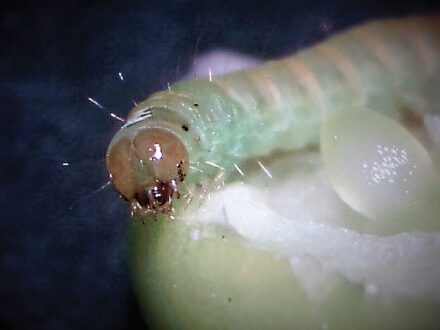

Apr 5, 2023Degree days determine cranberry spray protocols
Degree-day benchmarks offer cranberry growers an optimal spray window for controlling Sparganothis fruitworm.
Shawn Steffan, U.S. Department of Agriculture entomologist with the Agricultural Research Service and associate professor with the University of Wisconsin Department of Entomology, spoke at the 2023 Wisconsin Cranberry School in mid-January, providing an overview of calculating the optimal time to spray for cranberry insect pests.


Phenology models based on degree-day accrual represent a more accurate approach to cranberry pest management, Steffan said.
“Degree days are a powerful way of incorporating both temperature and time into one measurement to quantify the rate of plant or insect development,” he said. “It includes the element of time, but it is time that includes measurements of heat because insects experience time largely as a function of heat.”
For his research, Steffan tracked the growing degree days of the cranberry vines and the life cycles of three major cranberry pests: Sparganothis fruitworm, cranberry fruitworm and blackheaded fireworm.
Using trap-catch data from nine growing regions in Wisconsin, Steffan showed how the timings of moth emergence of the three pests are often highly synchronized with each other.
“All three of these moths come out of winter and tend to start their flight at about the same time, which is right around when the vines accumulate 900- to 1,000-degree days,” Steffan said.
It’s the larval or caterpillar stage of each pest that causes the most damage to cranberries.
“So often, our control tactics are aimed at hitting the larvae,” he said. “So it would be nice to know when they’re out.”
While all three pests emerge at the same time, the peak activity of the three insects varies. The peak flights for Sparganothis and cranberry fruitworm are similar, while blackheaded fireworm tends to peak earlier, Steffan said.
That means early spray timings for Sparganothis may also help control cranberry fruitworm and possibly blackheaded fireworm.


In 2018 field trials, Steffan and his research group applied insecticide at 25% egg hatch and 75% hatch, and a third trial in which insecticide was applied at 25% and 75% egg hatch.
The following year, the trial was modified to see whether it was helpful to spray even earlier, so sprays were timed for 10%, 25% and 40% egg hatch.
“We can look at any egg-hatch percentage and any spray tactic that is aiming for a particular pest,” Steffan said. “Do we want to spray at the front-end or the back-end of the peak? Do we go early, or do we go late? If we spray at 25%, we kill what has already hatched and spray residue on the leaves may potentially kill what will be hatching soon.”
Steffan and his researchers showed significantly more caterpillars were killed when the sprays were timed for 10% and 25% Sparganothis egg hatch.
“These two early times were similarly effective and both were much better than either the 40% or 75% times,” he said. “The increase in spray efficacy was significant, which means that growers can get a lot more out of a well-timed spray.”
While monitoring degree days to estimate egg hatch for Sparganothis, Steffan observed that at 25% egg hatch, about 90% of the adult moths were also present.
“So you can potentially knock out most of the adult female egg layers at the same time that you’re knocking out the hatched eggs,” he said. “You kill what’s already hatched, some of which will hatch soon and you also knock out lots of the egg layers, which preempts the existence of future eggs.”
Looking at the best time to control Sparganothis, Steffan advises spraying at 1,000 to 1,140 degree-day benchmarks. Because of the similarity in their life cycles, that same timeframe is also optimal to control cranberry fruitworm and much of the blackheaded fireworm population, Steffan said.
— By Lorry Erickson, FGN Correspondent














